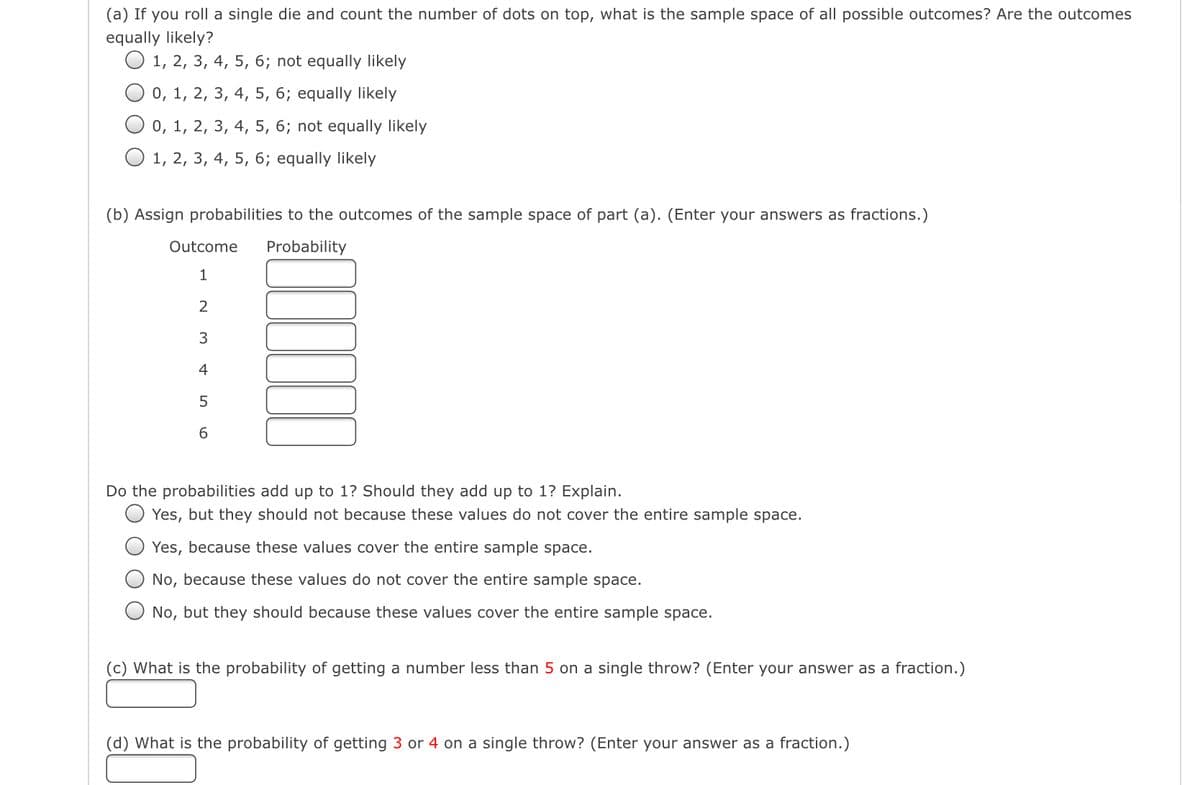(a) If you roll a single die and count the number of dots on top, what is the sample space of all possible outcomes? Are the outcomes equally likely? O 1, 2, 3, 4, 5, 6; not equally likely O 0, 1, 2, 3, 4, 5, 6; equally likely O 0, 1, 2, 3, 4, 5, 6; not equally likely O 1, 2, 3, 4, 5, 6; equally likely (b) Assign probabilities to the outcomes of the sample space of part (a). (Enter your answers as fractions.) Outcome Probability 1 5 6 Do the probabilities add up to 1? Should they add up to 1? Explain. Yes, but they should not because these values do not cover the entire sample space. O Yes, because these values cover the entire sample space. O No, because these values do not cover the entire sample space. O No, but they should because these values cover the entire sample space. (c) What is the probability of getting a number less than 5 on a single throw? (Enter your answer as a fraction.) (d) What is the probability of getting 3 or 4 on a single throw? (Enter your answer as a fraction.)
(a) If you roll a single die and count the number of dots on top, what is the sample space of all possible outcomes? Are the outcomes equally likely? O 1, 2, 3, 4, 5, 6; not equally likely O 0, 1, 2, 3, 4, 5, 6; equally likely O 0, 1, 2, 3, 4, 5, 6; not equally likely O 1, 2, 3, 4, 5, 6; equally likely (b) Assign probabilities to the outcomes of the sample space of part (a). (Enter your answers as fractions.) Outcome Probability 1 5 6 Do the probabilities add up to 1? Should they add up to 1? Explain. Yes, but they should not because these values do not cover the entire sample space. O Yes, because these values cover the entire sample space. O No, because these values do not cover the entire sample space. O No, but they should because these values cover the entire sample space. (c) What is the probability of getting a number less than 5 on a single throw? (Enter your answer as a fraction.) (d) What is the probability of getting 3 or 4 on a single throw? (Enter your answer as a fraction.)
Chapter9: Sequences, Probability And Counting Theory
Section9.7: Probability
Problem 4SE: What is the difference between events and outcomes? Give an example of both using the sample space...
Related questions
Question

Transcribed Image Text:(a) If you roll a single die and count the number of dots on top, what is the sample space of all possible outcomes? Are the outcomes
equally likely?
1, 2, 3, 4, 5, 6; not equally likely
0, 1, 2, 3, 4, 5, 6; equally likely
0, 1, 2, 3, 4, 5, 6; not equally likely
O 1, 2, 3, 4, 5, 6; equally likely
(b) Assign probabilities to the outcomes of the sample space of part (a). (Enter your answers as fractions.)
Outcome
Probability
1
3
4
Do the probabilities add up to 1? Should they add up to 1? Explain.
Yes, but they should not because these values do not cover the entire sample space.
Yes, because these values cover the entire sample space.
No, because these values do not cover the entire sample space.
No, but they should because these values cover the entire sample space.
(c) What is the probability of getting a number less than 5 on a single throw? (Enter your answer as a fraction.)
(d) What is the probability of getting 3 or 4 on a single throw? (Enter your answer as a fraction.)
Expert Solution
Step 1
When a single die roll, the sample space is given by
S = {1,2,3,4,5,6}
Trending now
This is a popular solution!
Step by step
Solved in 5 steps

Recommended textbooks for you



College Algebra (MindTap Course List)
Algebra
ISBN:
9781305652231
Author:
R. David Gustafson, Jeff Hughes
Publisher:
Cengage Learning



College Algebra (MindTap Course List)
Algebra
ISBN:
9781305652231
Author:
R. David Gustafson, Jeff Hughes
Publisher:
Cengage Learning